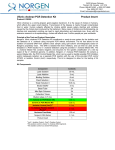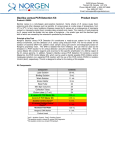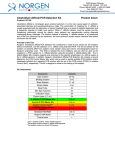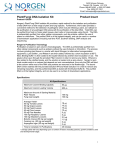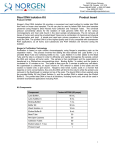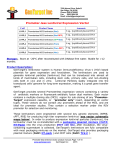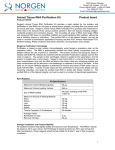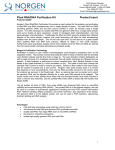Download MICROBIAL COLONY REPLICATOR User manual
Transcript
MICROBIAL COLONY REPLICATOR for ISO-GRID HGMF™ hydrophobic grid membrane filters User manual This Replicator permits preparation of HGMFs that accurately copy the colony pattern of an HGMF master. The ability to incubate replicates under a range of growth conditions is a useful diagnostic and research tool. Replicating HGMFs is a simple three-step process, viz: 1. Lock an Inoculator in the Replicator. 2. Register the HGMF "master" under the microscope crosshairs and pull the Operating Lever to charge the Inoculator. 3. Register a fresh HGMF under the crosshairs and pull the Lever to transfer a replica inoculum to it. However, there is a skill to learn and points to keep in mind. Also, this instrument differs in several ways from earlier Replicators. Please take a few moments to read this Manual. Contents 1. Replicator components 2. Replicating - keep in mind what's happening 3. Replicating - getting ready 4. Replicating - charging an Inoculator from the master HGMF 5. Replicating - making the copies 6. Cleaning, sterilization and care of Inoculators 7. About Focus 8. Lining up the Replicator (ISO-GRID HGMF is a registered trademark of QA Lifesciences Inc, San Diego, CA, USA) FILTAFLEX Ltd. Tel 613 256 3066 PO Box 1224 Fax 613 256 8681 Almonte Ontario K0A 1A0 www.filtaflex.ca Canada E-mail [email protected] Page 1 of 6 1. Replicator components Page 2 of 6 2. Replicating - keep in mind what's happening Remember that: i) An HGMF is very flexible - each Inoculator points deforms it and presses it into the agar; ii) The agar is like a sponge - the instant it is pressed it expresses water which floods back up into the HGMF grid-cell. If pressed for more than a second or so, water will swamp and contaminate adjacent grid-cells. Agars for different purposes have different sponginess. The skill to learn in replicating is to bring the Inoculator down onto the HGMF just firmly enough - and for long enough - that floodwater washes some microbial cells from the Inoculator point. But be careful not to press for too long or you will flush microbes into adjacent HGMF grid-cells (see 9. Flooding the HGMF). One second or less contact is enough... As agar plates dry the agar becomes harder and its surface becomes concave. This can cause incomplete inoculation. It is preferable to use plates containing 12-15 ml of fresh agar. The ample agar layer will ensure that the agar is resilient and planar enough to inoculate properly. The agar surface should be planar but does not have to be uniformly thick. The compressible HGMF Slider allows the Replicator to accommodate plates gelled on a non-horizontal surface. 3. Replicating - getting ready - have sufficient sterilized Inoculators ready; - lay sufficient sterile HGMF on their respective agar plates; - check the Replicator alignment. 4. Replicating - charging an Inoculator from the master HGMF i) Use the Operating Lever to raise the Inoculator Dock. Move the Inoculator Locking Lever to the left and slide a sterile Inoculator into the Locators. Touch only its "wings". ii) Turn the Inoculator Locking Lever to the right to lock the Inoculator. iii) Withdraw the HGMF Slider, place a master HGMF plate on it, then slide it under the Inoculator. (Note: If you try to slip a plate under an Inoculator without withdrawing the HGMF Slider you may touch and contaminate the Inoculator). iv) Align the HGMF "T" bar under the microscope crosshairs. Absolutely perfect registration is not essential - experience will show how accurate you must be. Keep fingertips in contact with both Base and HGMF Slider to steady them whilst aligning. v) Use the Operating Lever to bring down the Inoculator. The weight of the Inoculator, Dock, and Shaft will usually provide sufficient force on the HGMF. The force can be increased by pulling the Operating Lever gently - do not use excessive force. vi) A smooth "down-up" movement, without pause, is usually sufficient. More than 1 sec pause will usually swamp the HGMF. vii) Push the Operating Lever back to its "rest" position. viii) Make HGMF copies without delay - microbes die off quickly on a drying Inoculator. Page 3 of 6 5. Replicating - making the copies Make replicates by repeating this process on the fresh HGMFs. The Inoculator will inoculate 100% of the grid-cells of the first daughter HGMF. Because it loses microbial cells to the fresh HGMF its ability to provide 100% inoculation decreases for succeeding replicates. The number of replicates one can make before incomplete replications occur depends very much on the type of colonies on the HGMF master - it may vary from five to 20 or more. In general, using a fresh Inoculator is preferable to recharging one that has been used. 6. Cleaning, sterilization, and care of Inoculators i) If used Inoculators are wrapped and autoclaved as shown, they will be "points down" when unwrapped to avoid the chance of contaminating them by turning them over. Alternatively, autoclave them without wraps, in covered trays. ii) Epoxy Inoculators withstand mild acids, alkalis, chlorine disinfectants, and normal (121ºC) sterilization. Avoid warping by autoclaving "points up" on a flat surface, and do not stack them. Do not soak aluminum Inoculators in alkaline solutions. iii) For many purposes it is not necessary to clean (wash, brush) Inoculators between uses - just sterilize them (a slight build-up of denatured organic material actually improves the ability of the points to hold inoculum). Do not use replication for in-situ PCR procedures, even if DNAase treatments are employed, since the point surfaces may protect DNA. iv) If it appears that some warping has occurred (test prints made on a flat paper repeatedly miss in the same area) dress Inoculators by rubbing them gently on medium-grade (e.g., 320 grit) carborundum paper on a flat surface. Do not rub off excessive amounts - both point size and a tendency to spread microbes to adjacent HGMF grid-cells will increase. 7. About Focus The Replicator height was supplied adjusted so that the plane of an HGMF is in focus when it is on an agar plate of normal thickness on the HGMF Slider. There is no rack and pinion - if HGMFs on agar plates are not in focus loosen the Check Ring and Height Clamp knobs and raise or lower the whole body of the instrument. Raising or lowering the instrument body will not affect alignment since all components move simultaneously. Page 4 of 6 8. Lining up Although the Replicator will rarely go out of alignment it is advisable to check, every week, that a test print registers satisfactorily on an HGMF. You will need a rubber stamp-type ink pad, and an HGMF (or a photocopy). Note that along one border HGMFs have a white "T" design that allows them to be registered under the Replicator crosshairs. 1. Lock an Inoculator in the Inoculator Dock. 2. "Ink" the Inoculator by bringing it down onto the ink pad. 3. Lay the HGMF on the HGMF Slider, centre its "T" under the microscope crosshairs, and make a print. (If the plane of focus is too high, use a pad under the HGMF). 4. Check that ink dots in the print fall within their proper grid-cells over the full area of the HGMF. (Note: it is not essential that dots be perfectly centered in all grid-cells, but the better the alignment, the greater the tolerance you have when copying colonies. In fact, HGMFs vary slightly from one another). In the event that the print is out of register, use the Lineup Tool to re-align the Replicator. 1. 2. 3. 4. Lock the Lineup Tool in the Inoculator Dock. Use the Operating Lever to drop the Lineup Tool's cross-lines down into focus. Slacken off both Dock Clamp Knobs. Gripping both Dock Clamp Knobs between thumb and forefinger, slide the Dock around until the Lineup Tool's cross-lines register with the microscope crosshairs. 5. Retighten the Dock Clamp Knobs (Hint: alternately partially tighten opposite sides until Dock is tight). Do not over-tighten. Replicator Lineup Tool (matches the HGMF 'T') 6. Check alignment by making an ink print as above. 9. Flooding the HGMF Page 5 of 6 These Figures excellently illustrate the importance of controlling pressure, time, and also avoiding having a concave agar surface when replicating. HGMF 1 A master HGMF prepared from diluted bovine faeces on Violet Red Bile agar. HGMF 2 This replicate of HGMF 1 on Oxoid Chromogenic E. Coli agar clearly differentiates species. HGMF 3. A further replicate on Mueller/Hinton+antibiotic agar has reproduced the centre of HGMF 1 correctly, but there is a ring of positive grid-cells around the outside. The agar may have been concave due to incorrect drying; greater contact pressure/time on the HGMF at the edge of the Inoculator compared with its centre increased the risk of flooding. (Photos courtesy of Dr. D. Jordan, New South Wales Agriculture, Wollongbar, NSW, Australia) Page 6 of 6







